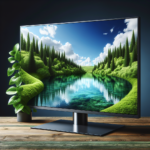Introduction to Widescreen Plasma Monitors
Widescreen plasma monitors have long been a staple in the world of home entertainment and professional displays. These monitors offer a unique blend of vivid colors, deep contrasts, and wide viewing angles, making them an ideal choice for various applications. But what exactly is a widescreen plasma monitor? This article delves into the features, benefits, and uses of these monitors, providing a comprehensive understanding for anyone interested in enhancing their viewing experience.
Key Features of Widescreen Plasma Monitors
Widescreen plasma monitors are known for their advanced features that set them apart from other types of displays. Here are some key features:
- Aspect Ratio: Typically, these monitors feature a 16:9 aspect ratio, which is perfect for widescreen viewing.
- Resolution: High-definition resolutions, often in the range of Full HD (1920×1080) or even 4K (3840×2160), provide crisp and detailed images.
- Color Accuracy: Plasma technology allows for excellent color accuracy and vibrant display.
- Contrast Ratio: High contrast ratios result in deeper blacks and brighter whites.
- Refresh Rate: Many plasma monitors have high refresh rates, reducing motion blur in fast-moving scenes.
| Feature | Description |
|---|---|
| Aspect Ratio | 16:9 |
| Resolution | Full HD (1920×1080) or 4K (3840×2160) |
| Color Accuracy | Excellent |
| Contrast Ratio | High |
| Refresh Rate | High |
Advantages of Widescreen Plasma Monitors
While there are many types of monitors available, widescreen plasma monitors offer several distinct advantages:
- Superior Image Quality: The vibrant colors and deep contrasts make for a visually stunning experience.
- Wide Viewing Angles: These monitors provide consistent image quality, even when viewed from off-center angles.
- Fast Response Time: Reduced motion blur is beneficial for fast-paced video content and gaming.
- Durability: Plasma screens are often more durable, especially in terms of pixel longevity.
Comparing Plasma with Other Display Technologies
It’s essential to understand how plasma monitors stack up against other popular display technologies like LCD and LED. Here are some comparisons:
- Plasma vs. LCD: Plasma monitors generally offer better color accuracy and contrast but may consume more energy.
- Plasma vs. LED: LED monitors are often more energy-efficient but may not match the deep blacks and high contrast ratios of plasma screens.
Uses of Widescreen Plasma Monitors
Widescreen plasma monitors serve various purposes, from home entertainment systems to professional environments. Here are some common uses:
- Home Theater: Their high definition and widescreen aspect make them perfect for home theater setups.
- Gaming: The fast response times and deep contrasts contribute to an immersive gaming experience.
- Professional Use: Ideal for broadcasting, content editing, and design due to their color accuracy.
Factors to Consider When Buying a Widescreen Plasma Monitor
When choosing a widescreen plasma monitor, there are several factors to consider:
- Budget: Determine how much you are willing to spend, as prices can vary significantly.
- Size: Consider the size of the monitor based on the space where it will be used.
- Resolution: Higher resolution screens provide better image quality but may come at a higher cost.
- Usage: Think about what you will primarily use the monitor for, such as gaming, movies, or professional work.
Conclusion
Widescreen plasma monitors offer an exceptional viewing experience with their vibrant colors, deep contrasts, and wide viewing angles. Whether for home entertainment, gaming, or professional use, these monitors stand out for their superior image quality and performance. By understanding the features and benefits, along with how they compare to other display technologies, you can make an informed decision when choosing the best widescreen plasma monitor for your needs.



